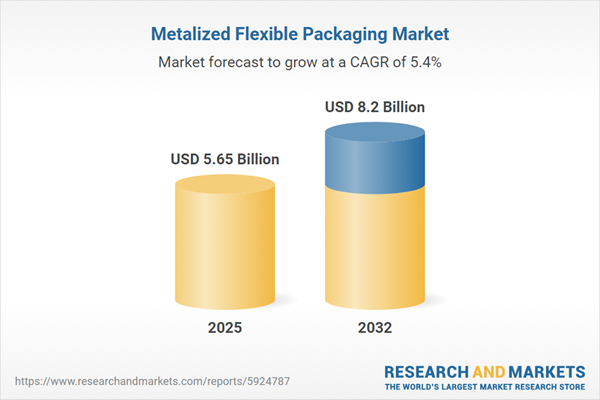Speak directly to the analyst to clarify any post sales queries you may have.
Metalized flexible packaging is rapidly transforming global supply chains by offering advanced barrier protection, lightweight formats, and enhanced visual appeal for consumer products. As industries prioritize sustainability, efficiency, and cost management, this market is reshaping strategies and value creation across key segments.
Market Snapshot of the Metalized Flexible Packaging Market
The Metalized Flexible Packaging Market grew from USD 5.37 billion in 2024 to USD 5.65 billion in 2025. It is expected to continue growing at a CAGR of 5.42%, reaching USD 8.20 billion by 2032.
Demand is being accelerated by changing consumer preferences for convenience and premium branding, alongside regulatory initiatives that foster new material innovations. These forces support ongoing market expansion, with diverse applications seen across vital industries such as food and beverage, personal care, and pharmaceuticals.
Scope & Segmentation: Comprehensive Coverage Across Materials, Technologies, and End Uses
- Film Types: Biaxially oriented polypropylene (BOPP), polyamide (PA), polyester (PET), and polyethylene (PE) are used according to performance needs for moisture resistance, tensile strength, and heat sealing.
- Metallization Method: Aluminum foil lamination and vacuum metallization offer flexible choices balancing production efficiency and product integrity.
- Printing Technology: Digital printing enables personalization and rapid design changes, while flexographic and rotogravure options meet higher-volume needs and established formats.
- Thickness Range: Substrates include < 30 microns, 30–60 microns, and >60 microns to meet application-specific requirements and optimize material use.
- End Use Industries: Solutions are developed for food & beverage, personal care & cosmetics, and pharmaceuticals, each demanding specific regulatory and product performance standards.
- Applications: Lidding, pouches, rollstock, sachets, and stick packs are tailored to enhance shelf life, branding, and portion control.
- Regional Markets: Americas (including North America and Latin America), Europe, Middle East and Africa, and Asia-Pacific, each reflecting unique demand drivers and regional supply chain adaptations.
- Notable Companies: Coverage includes market leaders and innovators such as 3M Company, Avery Dennison Corporation, Uflex Limited, Huhtamäki Oyj, Sonoco Products Company, Taghleef Industries SpA, Jindal Poly Films Ltd., Smurfit Kappa Group, and more.
Key Takeaways for Senior Decision-Makers
- Metalized flexible packaging has shifted from niche use to underpinning product differentiation and performance in global consumer markets.
- Advanced production methods, including digital printing and precision metallization, enable faster time-to-market and enhanced packaging customization.
- Sustainability is driving substrate innovation, including biodegradable and recycled materials, as manufacturers respond to evolving regulatory and consumer demands.
- Regionalized supply chains are being favored for cost stability and reduced transport emissions, enabling market participants to better manage geopolitical and raw material volatility.
- Segmentation reveals the strategic importance of balancing technical criteria (e.g., film thickness, metallization process) with end-use and branding objectives.
- Strategic partnerships—both across supply chains and with technology innovators—provide a pathway to accelerate market-responsive solutions and premium positioning.
Tariff Impact: Navigating Regulatory and Cost Realignment
Impending United States tariff adjustments on aluminum foils and certain film substrates will prompt organizations to reevaluate sourcing and procurement strategies. Supply chain and procurement leaders may explore alternative suppliers, long-term contracts, or regional manufacturing shifts, aiming to mitigate exposure and maintain uninterrupted production. Strong collaboration and scenario planning are crucial to offset cost adjustments and secure favorable pricing or inventory positions.
Methodology & Data Sources
This report utilizes a robust research approach, combining primary interviews with material suppliers, converters, and brand owners with secondary data from industry journals, patent filings, and regulatory sources. An iterative validation process, leveraging expert peer review and data triangulation, ensures findings provide a balanced industry perspective aligned with observable market trends.
Why This Report Matters for Strategic Decision-Makers
- Offers actionable insight into market shifts, emerging regulations, and the adoption of new film chemistries and metallization techniques.
- Enables the development of differentiated product strategies through a detailed understanding of technology, regional, and application-driven segmentation.
- Supports risk mitigation by analyzing procurement responses to tariffs and supply chain pressures across global regions.
Conclusion
This report arms industry leaders with vital intelligence to drive innovation, manage operational complexity, and capitalize on strategic growth opportunities. Robust segmentation and clear analysis empower confident, future-focused decisions within the evolving metalized flexible packaging market.
Additional Product Information:
- Purchase of this report includes 1 year online access with quarterly updates.
- This report can be updated on request. Please contact our Customer Experience team using the Ask a Question widget on our website.
Table of Contents
3. Executive Summary
4. Market Overview
7. Cumulative Impact of Artificial Intelligence 2025
Companies Mentioned
The companies profiled in this Metalized Flexible Packaging market report include:- 3M company
- Avery Dennison Corporation
- Bondline Electronics Ltd.
- Caltex Plastics Inc.
- Covestro AG
- Dunmore Corporation
- ESTER INDUSTRIES LIMITED
- Huhtamäki Oyj
- Hulamin Limited
- Jindal Poly Films Ltd.
- Kendall Packaging Corporation
- Nissha Metallizing Solutions
- Norsk Hydro ASA
- Ouma Industrial Limited
- Pactiv Evergreen Inc.
- Polinas Plastik Sanayii Ve Ticaret A.S.
- Polyplex Corporation Limited
- Shako Flexipack Private Limited
- Smurfit Kappa Group
- Sonoco Products Company
- Taghleef Industries SpA
- Toray Industries, Inc.
- Transcontinental Inc.
- Uflex Limited
- United Company RUSAL PLC by Glencore
- Wicklow, Inc.
- Wyda Packaging (Pty) Ltd.
Table Information
| Report Attribute | Details |
|---|---|
| No. of Pages | 186 |
| Published | November 2025 |
| Forecast Period | 2025 - 2032 |
| Estimated Market Value ( USD | $ 5.65 Billion |
| Forecasted Market Value ( USD | $ 8.2 Billion |
| Compound Annual Growth Rate | 5.4% |
| Regions Covered | Global |
| No. of Companies Mentioned | 28 |









